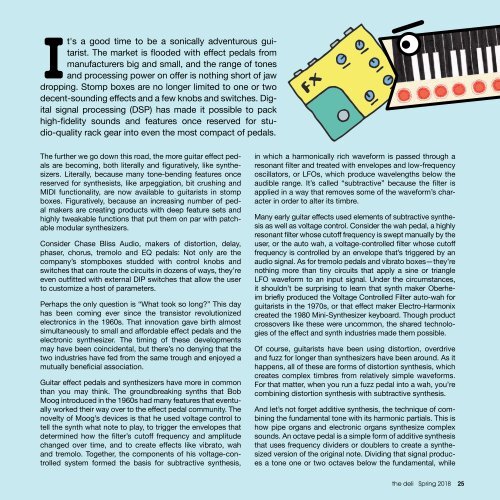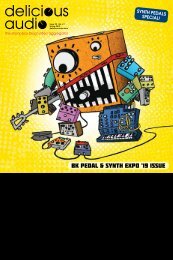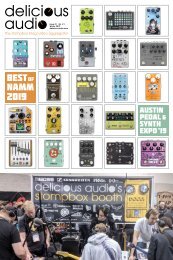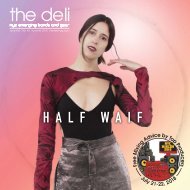Deli #54 - Bodega, Brooklyn Stompbox Exhibit and Synth Expo 2018
A magazine and website focused on emerging NYC artists and pedals!
A magazine and website focused on emerging NYC artists and pedals!
You also want an ePaper? Increase the reach of your titles
YUMPU automatically turns print PDFs into web optimized ePapers that Google loves.
It's a good time to be a sonically adventurous guitarist.<br />
The market is flooded with effect pedals from<br />
manufacturers big <strong>and</strong> small, <strong>and</strong> the range of tones<br />
<strong>and</strong> processing power on offer is nothing short of jaw<br />
dropping. Stomp boxes are no longer limited to one or two<br />
decent-sounding effects <strong>and</strong> a few knobs <strong>and</strong> switches. Digital<br />
signal processing (DSP) has made it possible to pack<br />
high-fidelity sounds <strong>and</strong> features once reserved for studio-quality<br />
rack gear into even the most compact of pedals.<br />
The further we go down this road, the more guitar effect pedals<br />
are becoming, both literally <strong>and</strong> figuratively, like synthesizers.<br />
Literally, because many tone-bending features once<br />
reserved for synthesists, like arpeggiation, bit crushing <strong>and</strong><br />
mIDI functionality, are now available to guitarists in stomp<br />
boxes. Figuratively, because an increasing number of pedal<br />
makers are creating products with deep feature sets <strong>and</strong><br />
highly tweakable functions that put them on par with patchable<br />
modular synthesizers.<br />
Consider Chase Bliss Audio, makers of distortion, delay,<br />
phaser, chorus, tremolo <strong>and</strong> EQ pedals: not only are the<br />
company’s stompboxes studded with control knobs <strong>and</strong><br />
switches that can route the circuits in dozens of ways, they’re<br />
even outfitted with external DIP switches that allow the user<br />
to customize a host of parameters.<br />
Perhaps the only question is “What took so long?” This day<br />
has been coming ever since the transistor revolutionized<br />
electronics in the 1960s. That innovation gave birth almost<br />
simultaneously to small <strong>and</strong> affordable effect pedals <strong>and</strong> the<br />
electronic synthesizer. The timing of these developments<br />
may have been coincidental, but there’s no denying that the<br />
two industries have fed from the same trough <strong>and</strong> enjoyed a<br />
mutually beneficial association.<br />
guitar effect pedals <strong>and</strong> synthesizers have more in common<br />
than you may think. The groundbreaking synths that Bob<br />
moog introduced in the 1960s had many features that eventually<br />
worked their way over to the effect pedal community. The<br />
novelty of moog’s devices is that he used voltage control to<br />
tell the synth what note to play, to trigger the envelopes that<br />
determined how the filter’s cutoff frequency <strong>and</strong> amplitude<br />
changed over time, <strong>and</strong> to create effects like vibrato, wah<br />
<strong>and</strong> tremolo. Together, the components of his voltage-controlled<br />
system formed the basis for subtractive synthesis,<br />
in which a harmonically rich waveform is passed through a<br />
resonant filter <strong>and</strong> treated with envelopes <strong>and</strong> low-frequency<br />
oscillators, or LFOs, which produce wavelengths below the<br />
audible range. It’s called “subtractive” because the filter is<br />
applied in a way that removes some of the waveform’s character<br />
in order to alter its timbre.<br />
many early guitar effects used elements of subtractive synthesis<br />
as well as voltage control. Consider the wah pedal, a highly<br />
resonant filter whose cutoff frequency is swept manually by the<br />
user, or the auto wah, a voltage-controlled filter whose cutoff<br />
frequency is controlled by an envelope that’s triggered by an<br />
audio signal. As for tremolo pedals <strong>and</strong> vibrato boxes—they’re<br />
nothing more than tiny circuits that apply a sine or triangle<br />
LFO waveform to an input signal. Under the circumstances,<br />
it shouldn’t be surprising to learn that synth maker Oberheim<br />
briefly produced the Voltage Controlled Filter auto-wah for<br />
guitarists in the 1970s, or that effect maker Electro-Harmonix<br />
created the 1980 mini-<strong>Synth</strong>esizer keyboard. Though product<br />
crossovers like these were uncommon, the shared technologies<br />
of the effect <strong>and</strong> synth industries made them possible.<br />
Of course, guitarists have been using distortion, overdrive<br />
<strong>and</strong> fuzz for longer than synthesizers have been around. As it<br />
happens, all of these are forms of distortion synthesis, which<br />
creates complex timbres from relatively simple waveforms.<br />
For that matter, when you run a fuzz pedal into a wah, you’re<br />
combining distortion synthesis with subtractive synthesis.<br />
And let’s not forget additive synthesis, the technique of combining<br />
the fundamental tone with its harmonic partials. This is<br />
how pipe organs <strong>and</strong> electronic organs synthesize complex<br />
sounds. An octave pedal is a simple form of additive synthesis<br />
that uses frequency dividers or doublers to create a synthesized<br />
version of the original note. Dividing that signal produces<br />
a tone one or two octaves below the fundamental, while<br />
the deli Spring <strong>2018</strong> 25







